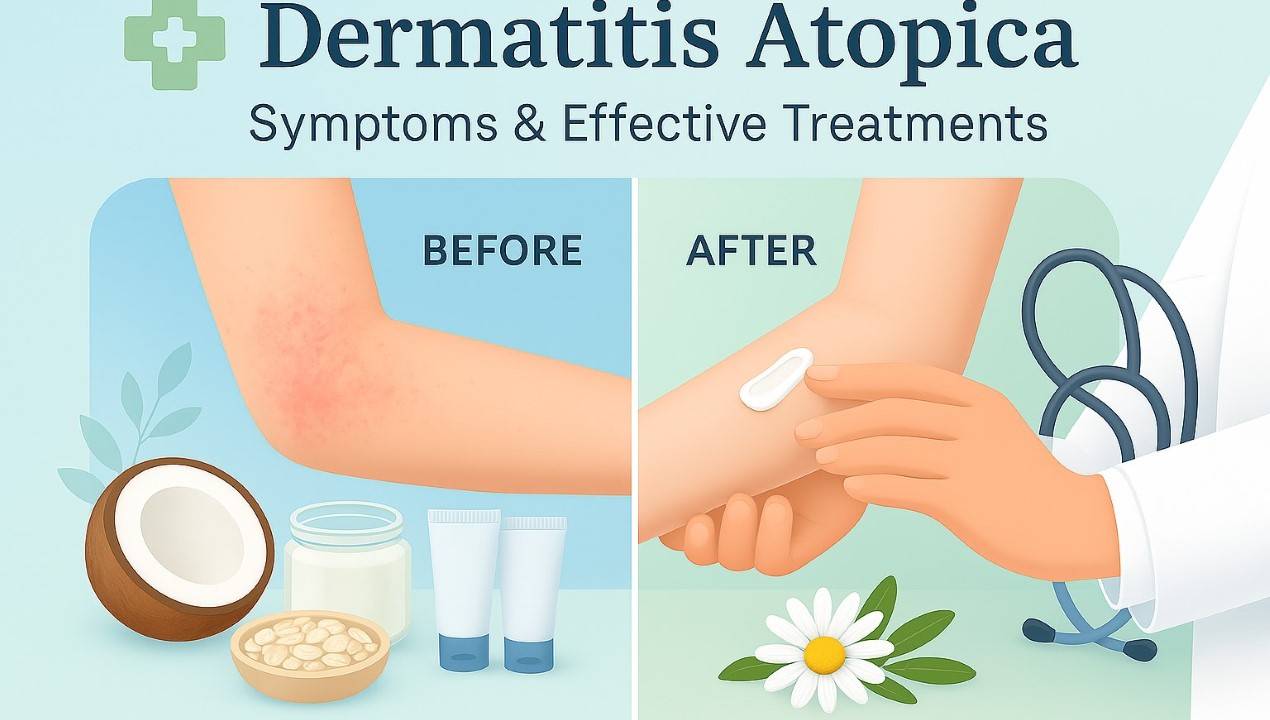Dermatitis Atopica is a common skin problem that affects millions of people around the world. This condition makes your skin red, itchy, and very dry. I have seen many patients struggle with this condition, but the good news is that there are many effective ways to manage it.
If you have dermatitis Atopica, you don’t have to suffer in silence. This guide will help you understand what it is and how to treat it effectively.
What Is Dermatitis Atopica?
Atopic dermatitis, often called eczema, is a persistent skin disorder marked by ongoing inflammation. The word “atopic” means your body reacts strongly to things that rarely bother other people. Their skin barrier is weakened in cases of atopic dermatitis.
This means their skin doesn’t protect them like it should. Moisture leaves the skin too easily, and irritants can get in more easily. I like this simple explanation because it helps people understand why their skin acts differently.
Common Symptoms of Atopic Dermatitis
The symptoms of atopic dermatitis are easy to spot once you know what to look for. Here are the most common signs:
Intense Skin Itching
Severe itching in atopic dermatitis often leads to scratching that breaks the skin. Scratching makes the condition worse and can cause infections.
Itchy Red Skin Patches
You’ll see red, angry-looking patches on your skin. These itchy red skin patches can be small or cover large areas. Red skin signals irritation and inflammation.
Chronic Dry Skin
People with dermatitis atopica have very chronic dry skin. The skin looks flaky or scaly. It feels rough when you touch it. This dryness is one of the salient features of the condition.
Thick, Cracked Skin
With time, atopic dermatitis can cause skin to harden, thicken, and crack, especially near joints.
Small Bumps
You might see small, raised bumps on your skin. These bumps can leak fluid if you scratch them.
Where Does Dermatitis Atopica Appear?
Dermatitis Atopica can show up anywhere on your body. But it has favorite spots:
In Babies (infant eczema):
- Face, especially cheeks
- Scalp
- Arms and legs
In Children (eczema in children):
- Elbow creases
- Behind the knees
- Neck
- Wrists and ankles
In Adults:
- Hands
- Face and neck
- Elbow and knee creases
- Feet
I have tested many products with families, and the location of the rash often tells us a lot about triggers.
What Causes Dermatitis Atopica?
Nobody knows the exact cause of dermatitis atopica. But doctors think several things work together:
Genetics and Allergic Predisposition
Dermatitis Atopica runs in families. It’s more likely to develop if inherited from your parents.
This is called allergic predisposition. Scientists have found genes that make some people more likely to have this condition.
Immune System Problems
People with dermatitis Atopica have immune systems that fight things that aren’t harmful. This fighting causes inflammation in the skin.
Environmental Triggers
Things around you can trigger allergic skin reactions. These include:
- Dust mites
- Pet hair
- Pollen
- Mold
- Certain foods
- Harsh soaps and detergents
- Stress
- Hot or cold weather
- Rough fabrics
Latest Atopic Dermatitis Treatment Options
The good news is that there are many atopic dermatitis treatment options available today. Zorite, a newly FDA-approved cream from July 2024, treats mild-to-moderate eczema in patients aged 6 and up.
Topical Treatments
Topical corticosteroids for dermatitis are still the primary treatment. These medications reduce inflammation and alleviate itching, and they come in various potencies from mild over-the-counter hydrocortisone to stronger prescription-only options.
Anti-inflammatory creams for eczema include:
- Topical Corticosteroids (steroid creams)
- PDE4 inhibitors (newer, safer options)
- JAK inhibitors (for severe cases)
I like the newer PDE4 inhibitors because they don’t have the same side effects as steroids.
Moisturizing for Atopic Dermatitis
Moisturizing for atopic dermatitis is the most important thing you can do. Use thick, fragrance-free moisturizers every day. The best moisturizers for eczema-prone skin are:
- Ceramide-based creams
- Petroleum-based ointments
- Hypoallergenic skincare for atopic dermatitis
Lock in moisture by applying cream to damp skin post-bath. This helps lock in moisture.
Systemic Treatments
For severe cases, doctors might prescribe pills or injections:
- Dupilumab (biologic injection)
- JAK inhibitors (oral medications)
- Immunosuppressants (for very severe cases)
Natural Remedies for Atopic Dermatitis
Many people find relief with natural remedies for atopic dermatitis. I have seen successful results when people combine these with medical treatments.
Oatmeal Baths for Atopic Dermatitis
Oatmeal baths for atopic dermatitis are very helpful. Lukewarm baths with colloidal oatmeal can ease eczema symptoms like itching in both kids and adults. Add colloidal oatmeal to your bath water. Soak for 5-10 minutes to help soften rough skin and relieve itching.
Natural Oils for Atopic Dermatitis
Natural oils for atopic dermatitis can be very soothing:
Coconut Oil: Coconut oil contains beneficial fatty acids that can add moisture to the skin and may protect the skin by helping to prevent inflammation and improving the health of the skin barrier. A 2024 study found that after a year of using coconut oil, participants experienced less itching and lower amounts of harmful bacteria on the skin.
Sunflower Oil: This oil has anti-inflammatory properties and helps repair the skin barrier.
Herbal Treatments for Atopic Dermatitis
Herbal treatments for atopic dermatitis that show promise include:
- Calendula (anti-inflammatory)
- Chamomile (soothing)
- Aloe vera (cooling and healing)
Chemical-Free Atopic Dermatitis Solutions
Chemical-free atopic dermatitis solutions are important for sensitive skin:
- Use fragrance-free products
- Choose organic cotton clothing
- Avoid synthetic fabrics
- Use natural, unscented detergents
Managing Eczema Flare-Ups
Managing eczema flare-ups requires a plan. Here’s what I recommend:
Immediate Relief
- Apply cool compresses
- Use gentle treatments for atopic dermatitis
- Take lukewarm baths with oatmeal
- Apply thick moisturizers
Long-term Management
- Identify and avoid triggers
- Use hypoallergenic skincare for dermatitis
- Keep stress levels low
- Follow a consistent skin care routine
Pediatric Atopic Dermatitis Care
Pediatric atopic dermatitis care needs special attention. Eczema is common in infants and often worries parents.
Special Care for Children
- Using extra-gentle products
- Keep fingernails short to prevent scratching
- Dress children in soft, breathable fabrics
- Create a calm bedtime routine
I have worked with many families, and consistency is key for managing children’s eczema.
Preventing Skin Infections in Dermatitis
Preventing skin infections in dermatitis is significant. Scratched skin can become infected easily.
Signs of Infection
- Increased redness
- Warmth
- Pus or yellow crusts
- Fever
- Worsening symptoms
Prevention Tips
- Keep skin clean and moisturized
- Don’t scratch (use cool compresses instead)
- Keep fingernails short
- Use antibiotic ointments as prescribed
Daily Care Routine for Atopic Skin Care
Good atopic skin care is about daily habits:
Morning Routine
- Gentle cleansing with lukewarm water
- Pat skin dry (don’t rub)
- Apply moisturizer while the skin is damp
- Use hypoallergenic skincare for dermatitis
Evening Routine
- Take a short, lukewarm bath
- Use gentle treatments for atopic dermatitis
- Apply thick moisturizer
- Use prescribed medications if needed
Clothing Choices
- Wear soft, breathable fabrics like cotton
- Avoid wool and synthetic materials
- Wash new clothes before wearing
- Use fragrance-free detergent
Sensitive Skin Care Routine
A good, sensitive skin care routine includes:
- Moisturizing creams for atopic skin (use 2-3 times daily)
- Gentle, fragrance-free cleansers
- Safe solutions for atopic dermatitis
- Avoiding known triggers
Soothing Atopic Dermatitis Naturally
Soothing atopic dermatitis naturally works well alongside medical treatments:
Stress Management
- Practice relaxation techniques
- Get enough sleep
- Exercise regularly
- Consider counselling if stress is a big problem
Diet Considerations
- Avoid known food triggers
- Eat anti-inflammatory foods
- Stay hydrated
- Consider probiotics
When to see a doctor
You should see a doctor if:
- Your symptoms don’t improve with home care
- The itching keeps you awake at night
- Your skin looks infected
- The condition affects your daily life
- You develop new symptoms
Steroid Cream Alternatives
Many people worry about using steroids long-term. Steroid cream alternatives include:
- PDE4 inhibitors (like the new Zoryve cream)
- Calcineurin inhibitors
- Natural remedies for eczema
- Organic relief for atopic dermatitis
Living with Dermatitis Atopica
Having dermatitis Atopica can be challenging, but it doesn’t have to control your life. With the right anti-inflammatory treatment and daily care, most people can manage their symptoms well.
Remember that this is a chronic condition. It might come and go throughout your life. But with proper care, you can have long periods without symptoms.
FAQs About Dermatitis Atopica
What is the best treatment for atopic dermatitis?
The best treatment depends on how severe your condition is. For mild cases, moisturizing for atopic dermatitis and gentle topical corticosteroids work well. For moderate-to-severe cases, newer treatments like PDE4 inhibitors or biologic medications might be needed. I always recommend starting with a good moisturizing routine and working with your doctor to find the right combination of treatments.
What causes atopic dermatitis?
Atopic dermatitis is caused by a combination of factors, including genetics, an overactive immune system, and environmental triggers. People with this condition have an impaired skin barrier that doesn’t protect the skin properly. Common triggers include dust mites, certain foods, stress, and harsh skincare products. It’s not contagious, and you can’t catch it from someone else.
Which drug is best for dermatitis?
There isn’t one “best” drug for everyone with dermatitis. Steroid creams remain the go-to treatment for most eczema cases. However, newer options like PDE4 inhibitors (such as the newly approved Zoryve cream) and JAK inhibitors are showing successful results with fewer side effects. For severe cases, biologic medications like dupilumab can be very effective. Your doctor will choose the best option based on your specific symptoms and medical history.
Is atopic dermatitis the same as eczema?
They’re the same condition — “eczema” is the everyday term, while “atopic dermatitis” is the clinical name. Both terms describe the same chronic skin inflammation that causes red, itchy, and dry skin patches. Some doctors use “atopic eczema” to be more specific, but they all refer to the same condition.
Conclusion
Eczema is widespread, yet treatable. Understanding your triggers and following a good skincare routine are key to controlling symptoms. With the right combination of eczema treatments and daily care, you can keep your skin healthy and comfortable.
Keep living fully—don’t let eczema hold you back. With proper management, you can have healthy, comfortable skin most of the time.



